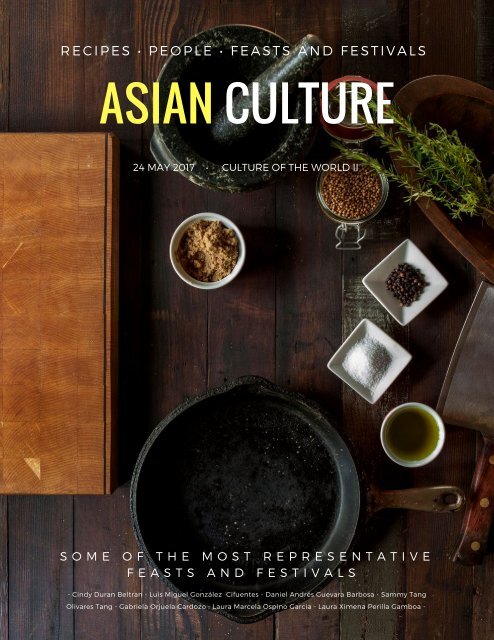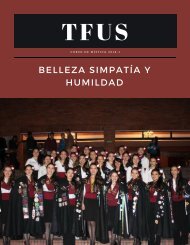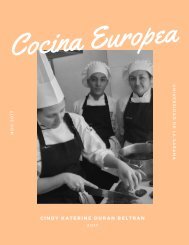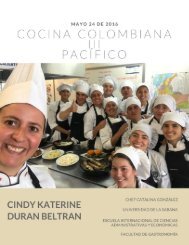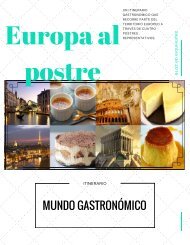Asian Culture
You also want an ePaper? Increase the reach of your titles
YUMPU automatically turns print PDFs into web optimized ePapers that Google loves.
O M E O F T H E M O S T R E P R E S E N T A T I V E<br />
S<br />
E A S T S A N D F E S T I V A L S<br />
F<br />
- Cindy Duran Beltran - Luis Miguel González Cifuentes - Daniel Andrés Guevara Barbosa - Sammy Tang<br />
R E C I P E S • P E O P L E • F E A S T S A N D F E S T I V A L S<br />
ASIAN CULTURE<br />
24 MAY 2017 • CULTURE OF THE WORLD II<br />
Olivares Tang - Gabriela Orjuela Cardozo - Laura Marcela Ospino Garcia - Laura Ximena Perilla Gamboa -
CONTENTS • GRILLED<br />
Table of<br />
Contents<br />
03<br />
07<br />
Chinese New Year<br />
The indian Maha-Prasada<br />
festivity<br />
10 Tsukimi<br />
13<br />
20<br />
22<br />
Diversity and tolerance:<br />
New year's celebrations in<br />
Thailand<br />
Japanese New year<br />
Have you ever been to a<br />
lantern festival, or have you<br />
ever wished upon releasing a<br />
sky lantern into the dark<br />
starry night?<br />
Korean Thanksgiving<br />
26
3
4
R E C I P E S • P E O P L E • G O O D F O O D<br />
FOODNOTES<br />
ISSUE NO. O2 • SEPTEMBER 2020 • $6.OO<br />
T H E N E W F A C E O F B A K I N G<br />
Guilt-free Brownies • Five Fresh grocery Picks • Top Organic Restaurants in the Metro<br />
Whole food marketing • Sweater Weather Recipes • Organic Farms up North<br />
5
6
7
Tsukimi<br />
⽉<br />
By Luis Miguel González Cifuentes<br />
Japan’s Harvest Moon Festival,<br />
autumn moon Festival Customs and<br />
traditional foods. It´s a long-held<br />
Japanese tradition.<br />
It’s really a traditional festival here in<br />
Japan, you can see all the<br />
preparations that the people do<br />
celebrate that.<br />
The Japanese custom of moon<br />
viewing is held in mind-autumn and is<br />
called Tsukimi or O-tsukimi (the<br />
honorific term). It is also referred to as<br />
the Mid-Autumn festival. It is widely<br />
celebrated all across Japan.
Tsukimi<br />
dango<br />
The Tsukumi moon viewing custom was the<br />
first introduced to Japan by China, during<br />
the Heian era (794 – 1185), where it was<br />
among a handful of seasonal celebrations of<br />
the beauty of nature. Court nobles<br />
celebrated O-tsukimi by indulging in<br />
banquets, musing and composing poems<br />
dedicated to the moon. Today, it’s<br />
celebrated at temples and shrines, such as<br />
Shimogamo shrine in Kyoto, where dances<br />
are performed in Heian-era dress to period<br />
music.<br />
It takes place on August 15th of the lunar<br />
calendar, and it’s also referred to as Jugoya.<br />
When I stayed in Japan, had the opportunity<br />
of witness this beauty festival, I was in a roji<br />
(dewy path”, a small Japanese tea garden)<br />
on my way to my friend’s tea house.<br />
However, as you round a bamboo fence, the<br />
tiny and simple thatched roof teahouse<br />
comes into view, and you notice that the<br />
windows are dark, and find this a just a little<br />
odd. In the tokonoma and there a scroll<br />
painting of a moon, barely visible<br />
against the palest grey sky, and a bold<br />
arrangement of pampas grass and<br />
autumn flowers are displayed. It’s<br />
grown chilly in recent days, so you’re<br />
happy when your host invites you to sit<br />
close to the coals as he prepares the<br />
kettle for tea.<br />
Then, the light begins to grown brighter<br />
to the east, and you look out of the open<br />
shoji doors to see the moon, barely<br />
visible at first, rising past the trees in<br />
the distance. The sky is cloudless and<br />
the air, clear, rendering the outline of the<br />
moon in crisp detail. As the moon<br />
appears, impossible huge and dazzling<br />
orange. As the moon scatters golden<br />
reflection on the garden pond below,<br />
you watch, speechless, as it rises, past<br />
the sweeping branches of the pines.<br />
11 PAGE
saidai no aki<br />
BY JAPANESE CHEF JINO AKIHIRA<br />
So, basically, you make offering and enjoy food<br />
and drink while everyone looks at the pretty<br />
moon. The offerings you give have various<br />
meanings to them. The most traditional food<br />
associated with Tsukimi are known as tsukimi<br />
dango, or small white dumplings made of rice,<br />
it look similar to a moon, so they symbolize<br />
thanks for the rice harvest. The tsukimi dango<br />
are typically displayed in an alter to represent<br />
an offering to the moon.<br />
Other foods wich are associated with tsukimi<br />
include chestnuts, known as “kuri” in Japanese,<br />
and taro, known as “sato imo”, in Japanese, as<br />
wells as kabocha (Japanese pumpkin).<br />
Boiled soba or udon noodles topped with nori<br />
and raw egg, then covered with broth are<br />
known as Tsukimi soba or Tsukimi udon. In<br />
Kitakyushu an egg served atop yaki udon is<br />
known as Tenmado, another name for<br />
Tsukimi in the local dialect. Similarly when a<br />
raw quail egg is used to top sushi, like<br />
battleship sushi gunkanzushi or a handroll<br />
temaki it is referred to as tsukimi style.<br />
Confectionary, such as Mooncakes, are also<br />
enjoyed.<br />
At some fast food restaurants in Japan a<br />
special Fall Menu is offered during September<br />
and October featuring fried egg sandwiches<br />
known as the Tsukimi burgers.<br />
12 PAGE
AND TOLERANCE:<br />
DIVERSITY<br />
YEAR’S CELEBRATIONS<br />
NEW<br />
THAILAND<br />
IN<br />
By: Laura Ospino García<br />
Thai Women<br />
celebrating Songkran,<br />
traditional Thai New<br />
Year Eve
Something that can be very disconnecting and even impressive<br />
about Thailand, is that there are three different new year<br />
celebrations throughout the year: according to western Christians<br />
traditions, Songkran of Hindu origin, and the Chinese New Year.<br />
These demonstrates the diversity of cultures and beliefs present<br />
in the territory, in addition to the tolerance and respect that exist<br />
with different practices and rituals.<br />
14
Firstly, regarding to western New Year’s<br />
Eve, it is only celebrated in areas with<br />
high concentration of tourists. It began<br />
to be held until a few years ago, with<br />
the influence of tourists and<br />
commercial importation. Thus, the best<br />
places to celebrate this date are the<br />
main regions of the tourist circuit, such<br />
as Koh Tao and Koh Phangan islands.
As for the Chinese New Year celebrations, and considering the<br />
roots of Chinese culture present in much part of the <strong>Asian</strong><br />
continent, this festival is celebrated with the arrival of the first full<br />
moon, especially in the Chinatowns of Chiang Mai, Phuket and<br />
Had Yai, however, it is important to mention that it tis in Bangkok<br />
where most people joint to the celebration.<br />
16
Thai New Year, or Songkran is<br />
one of the main festivities in<br />
Thailand, usually coincides with<br />
the days between April 13th and<br />
15th of the Gregorian calendar.<br />
This celebration has its origins in<br />
a traditional Hindu festival, the<br />
Sankranti. The Songkran is a<br />
great water festival, which<br />
symbolizes purification and<br />
renovation, so when people<br />
throw water at each other on the<br />
streets, it signifies the renewal of<br />
each person for the beginning<br />
year. It is also a tradition that the<br />
day before the beginning of the<br />
celebrations, people clean their<br />
houses very well.<br />
The Songkran has three stages,<br />
distributed in the three days that<br />
the celebration lasts. On the first<br />
day, it is a tradition for women to<br />
prepare traditional recipes that<br />
will be eaten over the next few<br />
days. It is worth highlighting the<br />
role of the female figure in this<br />
ritual, as is them who must know<br />
and follow recipes that their<br />
mothers and grandmothers have<br />
taught them, in order to reproduce<br />
these preparations, which will be<br />
offered to the monks in the<br />
temples.
Followed to this, families go to the banks of the<br />
rivers to lift sand pagodas decorated with<br />
flowers, this is done with the aim of atoning<br />
guilts and attract good luck for the coming year.<br />
For the second day, there are offering<br />
ceremonies in the Buddhist temples of each city,<br />
in addition, water battles take place this day,<br />
where both tourists and natives unite to throw<br />
water to each other, as purification and<br />
cleanliness of the spirit. Originally the Songkran<br />
was not as festive as it is today, previously the<br />
water was used only to wet the most revered<br />
statues of the Buddha, because it was believed<br />
that this water had beneficial and curative<br />
properties.<br />
In many parts of the country the<br />
celebrations of the Songkran<br />
ends on April 15th, however, in<br />
certain towns and cities these<br />
festivities extend until one<br />
week. This day is called the day<br />
of Wan Parg-bpee, and honors<br />
are rendered to all ancestors<br />
and to the oldest people. Water<br />
is usually spilled over older<br />
people as they ask for good luck<br />
for the next year. This<br />
ceremony is known as the Rohd<br />
Nam Songkran.<br />
18
Songkran trips:<br />
1. Wear eye protection and<br />
waterproof all your belongings.<br />
2. When buying a water gun make<br />
them test it first.<br />
3. Cover your ears as you’re passing<br />
when people are shooting water.<br />
4. Don’t shoot people in their ears nor<br />
eyes with a high-powered gun, most<br />
trouble starts from this.<br />
5. Spraying motorbikes or dry people<br />
can be fun to get wet, but be aware<br />
that this could cause trouble.<br />
6. Make reservations well ahead of<br />
the celebration.<br />
References:<br />
Wright St-Clair, V., Bunrayong, W.,<br />
Vittayakorn, S., & Hocking, C. (2011).<br />
Offerings: Food Traditions of Older Thai<br />
Women at Songkran. Journal of occupational<br />
science .
BY: LAURA XIMENA PERILLA GAMBOA<br />
is a major celebration worldwide, but<br />
This<br />
and manners change depending on<br />
traditions<br />
is a very large country, full of diversity, with<br />
Japan<br />
culture in which respect is more important than<br />
a<br />
New Year, also known as Shogatsu, is<br />
Japanese<br />
by one main tradition, followed by<br />
characterized<br />
that symbolize the same amount of worldly<br />
rings<br />
committed by the human race. These bell<br />
sins<br />
also mean that those sins, if committed<br />
rings<br />
the year that is about to end, are forgiven,<br />
during<br />
that people can start the new year being free<br />
so<br />
any bad behavior, and may continue their path<br />
of<br />
in order for everyone to share. This<br />
displayed<br />
is developed on December 31st, as well as<br />
ritual<br />
more different than what we are used to in<br />
way<br />
westernized world. For starters, not receiving<br />
the<br />
is considered a very rude act, because it<br />
food<br />
that you reject them and their culture.<br />
means<br />
families on new year´s eve gather around<br />
When<br />
table, everyone´s legs are covered by a sort of<br />
the<br />
that comes from underneath the table, so<br />
blanket<br />
everyone is comfortable. This is used mostly<br />
that<br />
that time of the year, because of winter´s cold<br />
at<br />
There´s no such thing as an<br />
temperatures.<br />
plate for each person at this table, all<br />
individual<br />
are arranged so that everyone shares, and<br />
plates<br />
a wide variety of food displayed. The only<br />
there´s<br />
that are served individually, for obvious<br />
things<br />
reasons, are beverages. But, you must never serve<br />
own beverage, it must be poured onto your<br />
your<br />
by someone else, as well as you are<br />
glass<br />
to serve others. To serve one´s beverage<br />
expected<br />
not considered polite nor thoughtful. This rule<br />
is<br />
for house-held meals, as well as those<br />
applies<br />
at restaurants.<br />
held<br />
interesting fact that Pablo shared, is that<br />
Another<br />
must never offer a bite of the food you´re<br />
you<br />
to someone else. Meaning, you cannot pass<br />
eating<br />
from your chopsticks onto someone else´s,<br />
food<br />
this symbolizes death. This is due to the<br />
because<br />
that when someone dies, at the ceremony<br />
fact<br />
person´s ashes are passed around, hand by<br />
the<br />
in order to say goodbye – so to do that with<br />
hand,<br />
food, is not just rude, is to wish for that person´s<br />
JAPANESE<br />
NEW YEAR<br />
FOOD AND MANNERS<br />
the territory, especially when we talk about Asia.<br />
Or at least that´s how I heard it from<br />
anything.<br />
a young Colombian who had the pleasure<br />
Pablo,<br />
from what he told me about food and every<br />
Now,<br />
that comes along with it, their traditions are<br />
ritual<br />
of living there for five years.<br />
People usually visit temples and<br />
others.<br />
in the ritual that involves 108 bell<br />
participate<br />
towards reincarnation.<br />
Pablo told me about the importance of<br />
Also,<br />
visits to the family. This is made by going<br />
paying<br />
every single house of the family, and eating -<br />
to<br />
receiving the food is considered extremely<br />
not<br />
but we´ll talk about that later on. Every<br />
rude,<br />
hold prepares the same dishes, and food is<br />
house<br />
on January 1st.<br />
death.<br />
20
the other hand, the amount of food in<br />
On<br />
plates is also very important. You´ll<br />
the<br />
see, for instance, four sushi rolls in<br />
never<br />
plate. For the Japanese, the number<br />
one<br />
also symbolizes death, because of<br />
four<br />
similarity of the phonetics between<br />
the<br />
words. On the contrary, number<br />
both<br />
is a symbol of good luck, so it is very<br />
eight<br />
to see eight elements arranged<br />
common<br />
one plate. Although that doesn´t mean<br />
in<br />
food is always displayed in this exact<br />
that<br />
amount.<br />
beginning to eat, people must say<br />
Before<br />
masu, which is grace, it means<br />
Itadaki<br />
grateful for the food about to be<br />
being<br />
This too, applies for every single<br />
eaten.<br />
deshita, which is also a<br />
Gochisousama<br />
of thanking the ones who took the<br />
way<br />
to prepare the food. During the<br />
time<br />
chopsticks must never touch the<br />
meal,<br />
table, it´s considered unsanitary<br />
dinner<br />
impolite.<br />
and<br />
for the food, one of the main dishes is<br />
As<br />
which is a sticky rice made by<br />
mochi,<br />
it and then pounding it with a<br />
cooking<br />
of hammer. In the pounding<br />
sort<br />
be eaten instead of the 12 grapes at<br />
to<br />
This buckwheat noodles are<br />
midnight.<br />
what people usually eat on January<br />
also<br />
garnished with different proteins for<br />
1st,<br />
every person in the house must<br />
process,<br />
is traditional for everyone to<br />
collaborate;<br />
help preparing all foods.<br />
the other hand, as Pablo told me,<br />
On<br />
is very important – it is considered<br />
soba<br />
lunch and dinner. Lastly, these<br />
breakfast,<br />
foods are usually accompanied by<br />
festive<br />
any kind of beer and/or sake.<br />
not just homemade ones. Also, at<br />
meal,<br />
end of the meal, the phrase used is<br />
the
M A Y 2 0 1 7<br />
Have you ever been to a lantern<br />
festival, or have you ever wished<br />
upon releasing a sky lantern into<br />
the dark starry night?<br />
BY: GABRIELA ORJUELA CARDOZO
E X C L U S I V E<br />
TAIWAN<br />
LANTERN<br />
FESTIVAL<br />
31 | Steam<br />
“…If there is one festival that I<br />
simply have to experience in my<br />
life, then the Taiwan Lantern<br />
Festival together with the Pingxi<br />
Sky Lantern Festival is it! A<br />
festival that is based on lights,<br />
lanterns and loads of firecrackers!<br />
This Lantern Festival is actually<br />
one of Taiwan’s tourism<br />
highlights…”<br />
When my dear friend Nicolas had<br />
the opportunitie to travel to<br />
Taiwain, his visit coincided<br />
Save.<br />
with both Yuan Xiao Jie as well the<br />
sister Ping Xi sky lantern festival.<br />
The Taiwan Lantern Festival is<br />
celebrated on the first full moon of<br />
the Chinese New Year. In 2017,<br />
the Taiwan Lantern Festival<br />
started from February 11th to<br />
19th, so he could experimented<br />
that incredible culture.
During the time he staied<br />
there,he learned so much about<br />
this festival, its history, its<br />
importance and its costums.To<br />
begin we must know that this<br />
festival also recive the name of<br />
‘Yuan Xiao Jie’. It is one of the<br />
more spectacular of the festivals<br />
in Taiwan and celebrates the end<br />
of the Lunar New Year, is<br />
centred around festivities such<br />
as lantern making, lantern riddle<br />
games, light shows, lantern<br />
parades……together with a<br />
beautiful display of decorative<br />
lanterns.is relevant to know that<br />
the lunar calendar is extremely<br />
important in Taiwan so it should<br />
come as no surprise that the first<br />
full moon of the year is a<br />
considered an auspicious time of<br />
the year and here are many<br />
traditions surrounding this<br />
special night. in that important<br />
momento, both young and old,<br />
venture out to celebrate the<br />
world-renowned Lantern<br />
Festival. Featuring everything<br />
from handheld children’s<br />
lanterns to huge floats bedecked<br />
Steam | 18<br />
in paper lights.
folklore. They decided to hold a major lantern<br />
small hillside town of Pingxi, is home to a<br />
The<br />
tradition that has made it a hugely<br />
breathtaking<br />
tourist destination. Around the time of<br />
popular<br />
first full moon sky lanterns are released to<br />
the<br />
heavens. These were once used as signals for<br />
the<br />
to let their families know they were safe<br />
villagers<br />
sound but now carry people’s wishes and<br />
and<br />
for the new year into the night sky. The<br />
hopes<br />
Xi Sky Lantern Festival is such an amazing<br />
Ping<br />
destination that it made it to the list of 10<br />
festive<br />
Winter Trips released by National<br />
Best<br />
Geographic.<br />
a numerous amazing festivals around the<br />
There<br />
but lantern festivals has got to be one of<br />
world,<br />
world’s most amazing ones. You simply<br />
the<br />
miss out on an event such as this! Here<br />
cannot<br />
will fill your life with light! Here, together<br />
you<br />
releasing an illuminated lantern into the<br />
with<br />
sky, you will let go of your worries and your<br />
starry<br />
of everyday life. Here you will find a true<br />
stresses<br />
of unity, love for all with a power of<br />
meaning<br />
See you all there!<br />
light!<br />
NOW, ABOUT HOW IT BEGAN?<br />
As Nicolas say: “Yuan Xiao Jie has got it all.<br />
Magic show of lights that will put a smile on<br />
the grumpiest faces. And for those with a<br />
curious appetite for Taiwan cuisine; you can<br />
enjoy in the traditional festival food. Among all<br />
the goodies on offer you will find: tangyuan<br />
(also called yuansiao), which are rice<br />
dumplings with either a sweet or savoury<br />
stuffing<br />
.<br />
Every year the festival is centred around a<br />
theme that is based on the zodiac of the year!<br />
In the year of 2016 the festival was based on<br />
the Year of the Monkey. The main lantern<br />
depicted a ‘’Golden Monkey Offering Peaches.<br />
2017 is the Year of the Rooster, it was an<br />
extraordinary spectacle.<br />
Now, about how it began?<br />
In 1990 the Tourism Bureau devised a plan to<br />
hold an event that would help celebrate local<br />
festival to coincide with age-old customs such<br />
as the Pingxi Sky Lantern Festival
26
27


